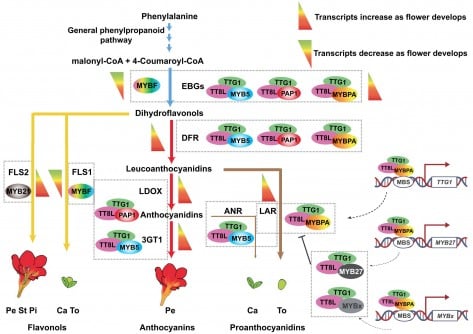BREAKING: A groundbreaking study has just revealed the intricate molecular mechanisms behind the vibrant pigmentation of the Freesia flower. Researchers from Northeast Normal University, Jilin University, and the China Tobacco Gene Research Center announced the findings on December 12, 2024, which could revolutionize the ornamental plant industry.
This urgent discovery centers on proanthocyanidins (PAs), critical flavonoids that not only protect plants from UV light, pathogens, and herbivores but also enhance the flavor of many fruits and beverages. Despite extensive research on these compounds in seeds and fruits, their regulatory pathways in flowers, particularly in monocots like Freesia, have remained largely unexplored—until now.
The research team systematically identified four TT2-type MYB transcription factors: FhMYBPA1, FhMYBPA2, FhMYBPA3, and FhMYBPA4. These proteins, localized in the nucleus, act as transcriptional activators that significantly correlate with PA accumulation in developing Freesia flowers. Remarkably, these findings highlight a previously overlooked part of the flower—the torus—which is crucial for metabolic processes.
By employing advanced techniques such as gene expression profiling and protein interaction assays, the team constructed an integrative model detailing how these MYB factors coordinate various metabolic pathways that dictate floral color and defense mechanisms. The urgent implications of this work are profound; it offers a roadmap for genetic modifications that could enhance flower color intensity and improve plant resilience against environmental stressors.
Prof. Yueqing Li, the corresponding author of the study, stated,
“Our research highlights the remarkable complexity of floral metabolism. We found that the TT2-type MYB regulators not only activate PA biosynthesis but also participate in a feedback system involving both activators and repressors.”
This feedback loop ensures a balanced production of pigments and protective compounds.
The study’s implications extend beyond ornamental plants. The findings could pave the way for developing new Freesia varieties with enhanced antioxidant properties, improving nutritional qualities in crops, and advancing the broader field of plant metabolic engineering.
As the ornamental market continues to grow, this research provides valuable genetic insights for breeding programs aimed at producing flowers with tailored pigmentation and increased stress tolerance. The identified regulatory modules serve as essential tools for scientists and breeders alike.
This significant advancement in understanding floral flavonoid pathways underscores the urgency for further research and application. The study, published in Horticulture Research, is available under DOI: 10.1093/hr/uhae352 for those interested in the full details of this transformative discovery.
Stay tuned for more updates on how these findings may change the landscape of ornamental horticulture and crop improvement. Share this news to keep others informed about this exciting development in plant science!







